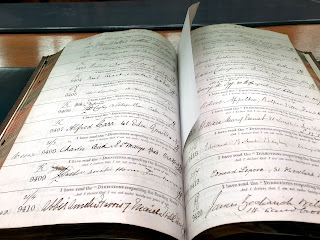Day 11: A Visit to the British Museum Archives
Brief history of the British Museum
Founded in 1759, it was the property of Sir Sloan who donated his estate and his collection of 70,000 objects to King George the II in exchange for 20,000 pounds for his family (British Museum, General Story). The British Library and the British Museum were in the same Montegu house until 1973.The Reading Room
The reading room is located at the Bloomsbury building. It opened to the public on 1857. You can see interesting details of the history and construction in the BM blog posted by the museum archivist (Hillier, 2018).Image credit: The Round Reading Room at the British Museum. The British Museum Blog
https://blog.britishmuseum.org/the-round-reading-room-at-the-british-museum/
The Central Archive Collection:
We were greeted by Francesca, the Archivist in charge who escorted us inside the Reading Room, which is not accessible to the public. The Reading Room is the repository for all of the items related to the inception and management of the British Museum. The building in itself is an amazing piece of work from the nineteenth century.The archives houses the very first meeting minutes that Sloan presided. The very first tickets that were designed to enter the museum dated 1,757. There are a wealth of business and legal records, documents and artifacts of value for the institution as these prove legal ownership of artifacts every time they have to handle restitution lawsuits such is the case with the lawsuit by Attorney Amal Clooney representing the government of Greece suing the BM to return the Parthenon remains.
Legal deeds from the Montegu land before the house was built, before it became the museum. endorsed by Queen Victoria dated 1,769. There are endless volumes of books containing meeting minutes from the very first meeting of the trustees. There are also accounting ledgers, payroll books.
You can also see sketches, blueprints, and photos that document the design, planning and building stages and the transformations of the reading room over the years as it was damaged extensively during World War II and it had to be rebuilt.
Another interesting facts is evidence that the museum had a growing population of cats. An article in BBC quotes: "Records in the British Museum's archive contain reports of kittens being born in the loading docks and running through the bookshelves of the museum library." They were about to be exterminated but an employee, Mr. Sheperd, saved the day by founding "The Cat Welfare Society".
Current Challenges:
There are various challenges to overcome as this area of the building is considered historical. The Reading Room was founded in 1850. By law, in the UK, the BM is required to preserve the building as much as possible. The BM and staff are aware of the improvements that need to be done and are doing the best they can to monitor the environment. The room is located in a basement where mold and humidity are a threat to the collections.They do have procedures in place to prevent fires, but no insurance as it is very expensive.
The 1963 Museum Act Freedom of Information, the BM can't loan anything wihtout permission, that is not catalogued, or stored properly. They recently underwent an inspection and they have a lot of improvements to make to meet the standards.
The archivists receive 4,000 inquiries a year and some require doing research as it is difficult to look at the indexes that kept records of the antiquities bequeathed many many years ago. Every inquiry is a learning opportunity. She still has cataloguing to do and it is a tedious and time consuming process you become the researcher and archivist at the same time.
I really enjoyed going to the British Museum. I will never forget this experience of learning about an archive, not any archive, definitely. There is so much history you can get lost just walking around the shelves. Keeping records according to standards must be overwhelming but is one of the main responsiblities of the archivist in charge.
References:
Bell, B. (2018) Beuraucats: The felines with official positions. BBC News. Retrieved from https://www.bbc.co.uk/news/uk-england-42098216
British Museum. The Museum Story. General History. History retrieved from: https://www.britishmuseum.org/about_us/the_museums_story/general_history.aspx
Hillier, F. (2018). The Round Reading Room at the British Museum. British Museum Blog. Retrieved from https://blog.britishmuseum.org/the-round-reading-room-at-the-british-museum/



Comments
Post a Comment